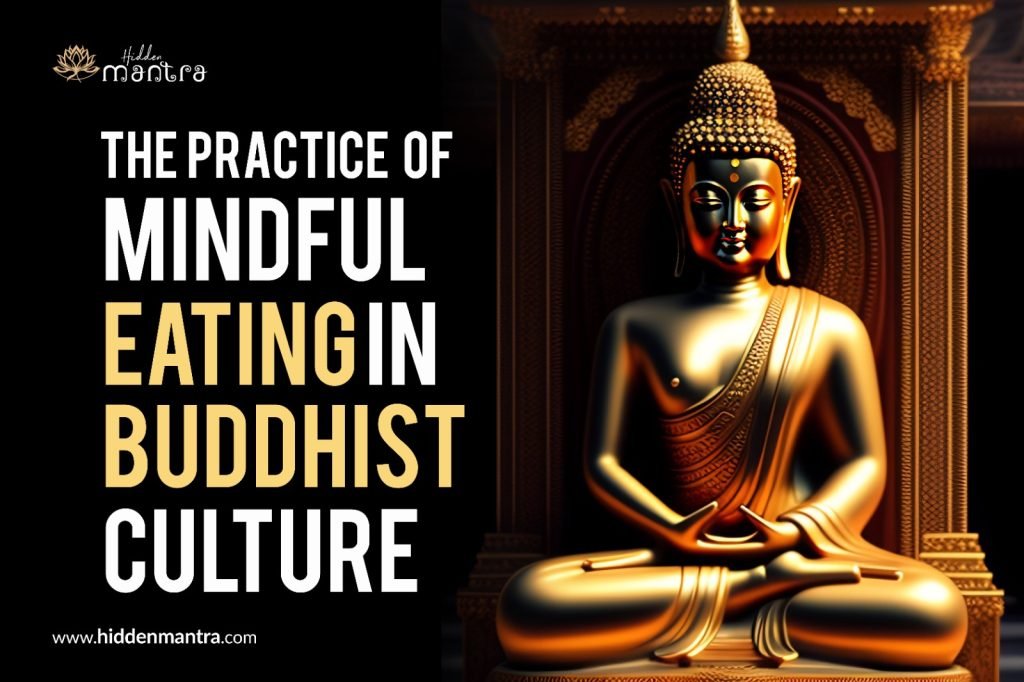“Let food be thy medicine and medicine be thy food.” – Buddha“
In today’s fast-paced world, where grabbing a quick meal on the go has become the norm, the concept of mindful eating offers a refreshing perspective. Rooted in Buddhist culture, the practice of mindful eating encourages individuals to approach their meals with a heightened sense of awareness and gratitude. Hidden Mantra, dedicated to exploring ancient traditions and promoting mindfulness, delves into the rich tradition of Buddhist eating.
Buddhist eating practices adopt the concept of mindful eating, realising the transformative power of being fully present during meals. Mindfulness plays a crucial role in various aspects of Buddhist practice, and when applied to eating, it enables a deeper connection to the present moment and cultivates a sense of gratitude. By including mindfulness in Buddhist eating, individuals feed their bodies, minds, and spirits in a more holistic and intentional manner. Let’s explore the importance of mindful eating in Buddhist culture and its impact on the practice of mindfulness.
Understanding Buddhist Eating Principles
The Concept of Mindful Eating
At the core of Buddhist eating lies the practice of mindfulness, which involves being fully present at the moment. When it comes to food, this means saving our attention to each bite, and savouring the flavours, textures, and smells. By developing mindfulness, individuals can deepen their connection with the food provided by the meal, promoting a sense of appreciation and enjoyment.
The Role of Compassion in Buddhist Eating
Buddhism teaches us to be kind and compassionate towards all living beings. This kindness extends to the way we choose and consume our food. Buddhist eating promotes making mindful choices that cause the least harm to other living beings.
It encourages individuals to choose plant-based or ethically sourced food options. This is because Buddhists believe that all forms of life are connected, and by choosing such foods, they aim to reduce the suffering of animals and promote harmony in the world.
The Notion of Non-Attachment to Food
In Buddhism, they believe that getting too attached to things can make us unhappy. When it comes to food, non-attachment means understanding that meals are meant to give our bodies the food they need, not just satisfy our desires or cravings. By letting go of being too strict about what we like or expect from our meals, we can approach them with an open mind. This allows us to appreciate and enjoy a wider variety of flavours and ingredients.
Rituals and Practices in Buddhist Eating
Food Offerings and Rituals
In Buddhism, there are special ceremonies where people offer food as a way to show thanks and respect. These offerings are a symbol of being generous and are given to deities, ancestors, or monks. By taking part in these rituals, people learn to be more grateful for the food they have and become more humble in their attitude.
Mindful Meal Preparation
Buddhist eating extends beyond the act of consuming food and encompasses the process of meal preparation itself. Cooking becomes a meditative practice, where individuals focus on each ingredient, engage their senses, and infuse the act with intention and gratitude. This mindful approach to cooking transforms the kitchen into a sacred space.
Eating in Silence
To foster a deeper state of mindfulness, Buddhist eating often involves eating in silence. By eliminating distractions and engaging fully with the meal, individuals can heighten their awareness of taste, texture, and satiety. Eating in silence also promotes a peaceful environment and allows for reflection and introspection.
Mindful Eating Techniques
- Slow and Conscious Eating
- Mindful Portion Control
- Engaging the Senses
Buddhist eating encourages us to eat slowly and with focus, even though life can often be busy and rushed. By taking our time to chew our food well and really savour the flavours, we can enjoy our meals more and feel more satisfied. Eating slowly also helps our digestion and lets our bodies tell us when we’re full, so we don’t overeat.
Mindful Portion Control
Mindful eating means paying attention to our body’s signals of hunger and fullness. This helps us eat just the right amount, neither too much nor too little. By listening to our body and being aware of how it feels, we can have a healthy relationship with food. This way, we can avoid gaining weight that we don’t need and prevent any discomfort from eating too much.
Engaging the Senses
Buddhist eating teaches us to use all of our senses when we eat. This means paying attention to the colors, smells, and textures of the food, and appreciating how it looks on the plate. By fully experiencing the sensory aspects of a meal, we can develop a stronger connection with the nourishment it provides.
Applying Buddhist Eating Principles in Everyday Life
Mindful Food Choices
Buddhist eating goes beyond just eating food. It also includes making thoughtful choices about the food we eat. Buddhists encourage people to think about the effects their food choices have on the environment and the well-being of others. This might mean choosing foods that are produced locally or without harmful chemicals, supporting farmers who use sustainable methods, or deciding to eat more plants and less meat. By making these conscious choices, individuals can contribute to a healthier and more harmonious world.
Cultivating Gratitude
Buddhist eating highlights the cultivation of gratitude for the abundance of food and the interconnectedness of all beings involved in its production. Individuals are encouraged to express gratitude before, during, and after meals, recognizing the efforts of farmers, suppliers, and cooks. This practice deepens the appreciation for the sustenance provided and fosters a sense of humility and interconnectedness.
Extending Mindfulness Beyond the Plate
The principles of Buddhist eating can be extended beyond mealtime to other aspects of daily life. By incorporating mindfulness into daily activities such as walking, working, or interacting with others, individuals can create a holistic approach to well-being based on Buddhist principles. This integration of mindfulness fosters a greater sense of peace, clarity, and compassion.
Conclusion
Mindful eating in Buddhist culture provides a special way to think about food. When people use mindfulness, kindness, and not being too attached, they can feel more connected to their food. They can also be more thankful and use mindfulness in all parts of life. Hidden Mantra wants you to learn about Buddhist eating and use it in your own journey to a thoughtful and happy life.
Let the wisdom of Buddha’s daily quotes guide you on your journey through each day.









9 Responses
Thank you I needed this reminder I have not
been appreciative of what a blessed being I truly am Thank you so much from now on I am wide awake’ Love n Light upon you always 🤍
I am not sure the place you’re getting your info, but great topic. I needs to spend a while learning more or working out more. Thank you for excellent information I was in search of this info for my mission.
Hiya very cool web site!! Guy .. Excellent .. Amazing .. I’ll bookmark your web site and take the feeds alsoKI am satisfied to seek out numerous useful info here in the publish, we’d like work out more strategies on this regard, thanks for sharing. . . . . .